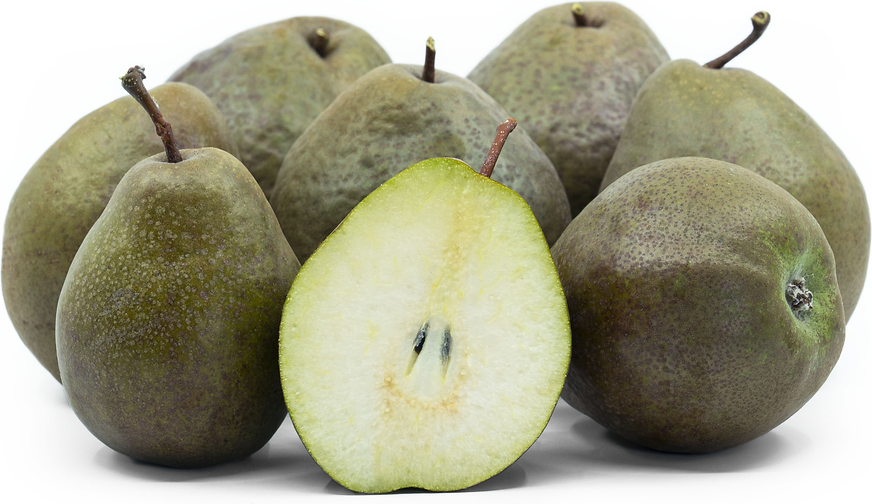


Black Worcester Pears
Estimated Inventory, lb : 0
Description/Taste
Black Worcester pears are medium to large in size, averaging 6 to 7 centimeters in diameter, and have an oval to pyriform shape with a bulbous base and short, thick neck. The pear's skin has a light, sandy texture with small bumps creating pocks on the surface, and while the skin is tough and firm, it can be easily punctured with a fingernail. The skin also has a dark brown to olive green hue, sometimes blushed with faint shades of maroon or covered in russet, and has a light green ring surrounding the eye at the base of the fruit. Underneath the surface, the flesh is ivory to cream-colored, with a hint of pale green just below the skin. The flesh is firm, dense, and gritty, encasing a central core filled with tiny black seeds. Black Worcester pears have a bitter, hard, and sharp, unpalatable taste when raw. The pears must be cooked, developing a soft and tender consistency with a mild and subtly sweet flavor.
Seasons/Availability
Black Worcester pears are available in the mid-fall through spring.
Current Facts
Black Worcester pears, botanically classified as Pyrus communis, are an ancient variety belonging to the Rosaceae family. The dark brown-green pears grow on trees that can be small and compact to large, reaching up to fifteen meters in height, depending on the rootstock, and were thought to have been introduced into England with the Romans. Black Worcester pears are one of the oldest pear varieties in existence in England. They were once an important food source during the bleak winter months as the pears can be stored for an extended period without decay. The variety is also regionally known as Iron pears, Parkinson's Warden pears, Worcester Black pears, Warden pears, and Worcester Pearmain pears. Black Worcester pears are a culinary variety only consumed once cooked for several hours to develop a soft and tender consistency. Over time, with the invention of freezers and modern pear varieties, cooking pears, including Black Worcester, faded from commercial popularity. In the modern day, Black Worcester pears are rare and are only found in small quantities in private orchards and estates throughout England.
Nutritional Value
Black Worcester pears have not been studied for their nutritional properties. Like other cooking pears, the variety contains a small amount of vitamin C to strengthen the immune system while reducing inflammation. The pears also provide fiber to regulate the digestive tract, potassium to balance fluid levels, calcium to build strong bones and teeth, and trace amounts of vitamin K, copper, and magnesium.
Applications
Black Worcester pears must be cooked and have a mild, subtly sweet taste. The pear's flesh is too firm and unpalatable when raw, and historically the fruits were slow-cooked in spices to develop a tender consistency. Black Worcester pears can be stewed, cooked in syrup, or stuffed and baked in decadent sauces for added flavor. The pears can also be cooked and added to pies, tarts, and other pastries. The mild nature of Black Worcester pears allows the fruit to be incorporated into sweet or savory dishes. In England, the pears were traditionally simmered in wine and served with meats such as quail, venison, sturgeon, or pork. Black Worcester pears compliment the flavors of aromatics such as garlic, onions, and shallots, nuts including almonds, pecans, or walnuts, vanilla, chocolate, and maple syrup. Whole, uncooked Black Worcester pears can be stored for 4 to 6 months in a cool and dark location.
Ethnic/Cultural Info
Black Worcester pears have been a symbol of the city of Worcester and the surrounding countryside for many centuries. It is believed that in 1575, a pear tree was moved to the front of a gate that Queen Elizabeth was going to be passing through to add beauty to her view. Queen Elizabeth saw the Black Worcester tree, enjoyed the pears and decided to place the pears onto the city’s coat of arms. The Worcester coat of arms still bears this pear today, along with the county council crest and the badges of the city's cricket and rugby teams.
Geography/History
The exact origin of the Black Worcester pear is unknown, but it is believed to have been introduced to the United Kingdom by the Romans and was first recorded by the monks at the Abbey of Warden in Bedfordshire as early as 1388. Today, Black Worcester pears are not grown commercially, but trees are available for propagation at many nurseries in England. They can also be found through select farmers markets and specialty grocers in Europe and the United States.
Recipe Ideas
Recipes that include Black Worcester Pears. One
| Brooklyn Supper |
|
Pear and Cabbage Slaw |
| The Circus Gardener's Kitchen |
|
Almond Stuffed Pears with Chocolate Sauce |
Podcasts




